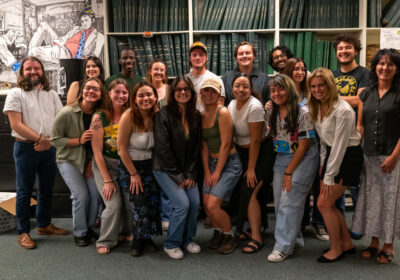Bringing all of Bob Dylan back home
Iconic musician Bob Dylan will soon occupy the same space as students when he and his backing band play in the Sun Dome on Thursday at 8 p.m.
Yet for students new to Dylan, it can be hard to know where to start within his eclectic 48-year recording career. His career ranges from acclaimed albums like “Blonde on Blonde” – and the video for “Subterranean Homesick Blues” recently used in a Google Instant commercial – to less recognized albums like “Oh Mercy.”
In other words, his identity is a rabble-rouser, born-again Christian, potent poet or even Christmas caroler depending on the album in one’s hands.
The Oracle helps out with five easy-entry albums to prepare for Dylan’s appearance.
“The Freewheelin’ Bob Dylan”
Known for a musical style that pairs a harmonica’s blues sound and an acoustic guitar’s classical sound with revolutionary political and poetic lyrics, Bob Dylan’s second album “The Freewheelin’ Bob Dylan” marked yet another important change for Americans in 1963.
Best known for its single “Blowin’ in the Wind,” Dylan’s album features acoustic, somber melodies that comforted Americans navigating the seas of the civil rights movement and mourning the death of President John F. Kennedy.
In the album, Dylan showcases the diversity of his early songwriting, which ranges from love songs like “Girl from the North Country” to satirical political humor in “Talkin’ World War III Blues” – which parodies an anxious American society fearing nukes and the invasion of Commies.
“The Freewheelin’ Bob Dylan” continued to refine Dylan’s musical characteristics that premiered in his first album and offered humor and originality that still inspires listeners today.
– Chloe Lykes
“Bringing It All Back Home”
Ranked No. 31 on the 500 greatest albums of all time by Rolling Stone, “Bringing It All Back Home” offered a side of Bob Dylan never heard before.
Though the album contains acoustic songs, Dylan implemented electric guitar on the record’s first side – a move that caused commotion amongst the folk music scene. This new bluesy-rock sound, paired with introspective lyrics, broadened his musical identity and influenced other ’60s artists such as The Beatles.
The album’s “Subterranean Homesick Blues” is listed among four other Dylan songs in the Rock and Roll Hall of Fame’s 500 songs that shaped rock and roll.
In this song, and “It’s Alright Ma (I’m Only Bleeding),” Dylan showcases a spoken word style comparable to rap with lyrics like “You don’t need a weatherman to know which way the wind blows” and “He not busy being born is busy dying.”
– Megan Freemyer
“Highway 61 Revisited”
“Highway 61 Revisited” scores even higher with Rolling Stone as the number four album of all time. The album’s opening track, “Like a Rolling Stone,” is now considered one of Dylan’s greatest hits.
However, when the record was released in 1965, it was met with mixed emotion. The 2005 documentary “No Direction Home” by Martin Scorsese shows Dylan playing to booing audiences after the record’s release.
In the film, Dylan says, “An artist has got to be careful never really to arrive at a place where he thinks he’s at somewhere. You always have to realize that you’re constantly in a state of becoming.”
“Highway 61 Revisited” – with songs like “Ballad of a Thin Man” and “Desolation Row” – shows Dylan “becoming” a legend.
– Corin LaPointe-Aitchison
“Blood on the Tracks”
Although Dylan said he could never comprehend the acclaim for “Blood on the Tracks” and “people enjoying that type of pain,” the record endures because it has his best combination of raw emotion and abstract mystery.
“Idiot Wind” has the angry momentum of a hurt lover’s insult, with boisterous organs and scathingly direct lines like “You’re an idiot, babe, it’s a wonder that you still know how to breathe.” Yet the gorgeous “Bootleg Series Volume 1-3” acoustic version reveals the song’s damaged nature.
Meanwhile, “You’re Gonna Make Me Lonesome When You Go” contains some of his most wistful and straightforward lyrics, while still mentioning 19th century poet Arthur Rimbaud and the small Ohio town of Ashtabula.
The last two songs “Shelter from the Storm” and “Buckets of Rain” close the record with the feeling of an emotional cleansing. Dylan denies that the album is autobiographical, but its influence can still be seen on introspective relationship albums like The Mountain Goats’ “Get Lonely.”
– Jimmy Geurts
“Desire”
“Desire” was released 35 years ago and remains relevant today because of the abundant personal passion and storytelling within Dylan’s 17th studio album.
The record contains nine tracks – each renowned for telling an intricate story and many lasting over seven minutes. “Hurricane” is an impassioned protest of the imprisonment of boxer Rubin Carter, and “Sara” is a heartfelt ballad reaching out to Dylan’s soon-to-be estranged wife.
Whether Dylan conveys a protest story or a personal tale, he relays his message in a way that relates to listeners even totally unrelated to the subject. The music’s pure integrity is undeniable and surely worth listening to, and a young Emmylou Harris even sings harmonies on “One More Cup of Coffee” and other songs.
The interlacing of classic rock and passionate folk storytelling makes for a truly remarkable album that’s compelling beyond its years.
-Tara Petzoldt






